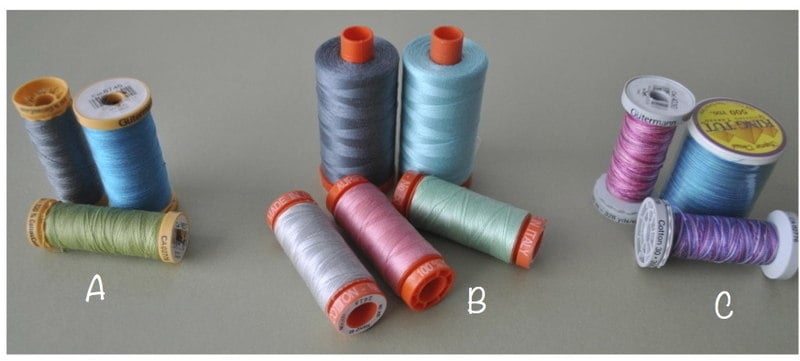Quilting Thread Know-How
There are so many different threads available these days, that the choice can be overwhelming sometimes. Not only are there different weights, but also composition, and choosing the right one for the job in hand can be tricky. So here is a breakdown of the threads I use:

For piecing and general sewing - I use a 50weight 100% cotton, (A & B) if you are using good quality 100% cotton fabrics, you should use the same composition in your thread, so 100% cotton is best. A 50wt is good for hand and machine piecing, as well as sewing on binding.
For machine quilting - again, I do use the 50wt for this, but also a 30 or 40wt cotton (C) to give more definition to my quilting stitches. Variegated threads are great for quilting as they add even more interest to the quilt design. I have also used a rayon thread for quilting (E). In the past it was said that polyester threads were too harsh for quilting through cotton and they would rip the fabric. However, polyester threads are of much better quality these days, and can add a beautiful sheen or texture to a quilt top.

For hand quilting - as you are going in and out of the fabric so often when hand quilting, you need a stronger cotton (D) which will stand up to the tension and not break. These threads are therefore waxed to give them extra strength. You can also buy pieces of beeswax to wax your own cotton threads.
For appliqué - I love using a silk thread (F) for hand work as it more or less disappears when you slip stitch your shape in place. For machine appliqué I would use a 30/40wt cotton, again possibly variegated for added interest - these look great in a buttonhole or satin stitch!
Craftsy has an excellent breakdown on threads here – What Type of Thread to Use.
When it comes to choosing the right colour, for white and paler fabrics, a white cotton is fine. But what to use when your fabrics are all different colours? Well, surprising as it may seem, if you use a medium grey or beige for piecing, these will blend into the fabrics nicely and not be seen. When it comes to quilting, you could use an invisible or monofilament thread - again Craftsy explains this thread much better that I ever could!
I am currently in love with Aurifil threads, as are many in the quilting community. Their threads come in four different weights and you can find out more on their fantastic website.